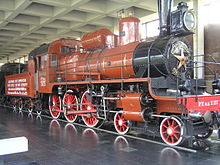Alfred de Glehn

Alfred George de Glehn (* 1848 in Sydenham ( Great Britain ), † 1936 in Mulhouse ) was a mechanical engineer . He became known for the development of the four-cylinder compound engine for steam locomotives .
Life
De Glehn's father Robert von Glehn came from a Baltic German family, his mother Agnes Duncan was a native of Scotland . The Reval cellist Alfred von Glehn was his cousin.
He studied mechanical engineering at King's College in London. After graduation, he was not employed in Great Britain and therefore settled in Le Havre . At first he was employed in the shipyards and in the forges. Later he dealt with the construction of ship engines . As a result of the outbreak of the Franco-Prussian War in 1870, he returned to Great Britain to enlist in the army. From 1870 studies at the Polytechnic in Zurich followed in order to complete theoretical knowledge.
In 1872 he began working for the French Société Alsacienne de Constructions Mécaniques (SACM) as a senior engineer . In 1875 he became head of the locomotive development office and in 1878 after the death of Édouard Beugniot, director on duty. Here he investigated ways of applying the principle of composite action to steam locomotives . The composite steam locomotive No. 701 developed from this in 1886 together with Gaston du Bousquet had two outer high-pressure cylinders for the rear drive wheels and two low-pressure cylinders for driving the front wheel axle.
The locomotives of the 2'B-1 '- "Atlantic" type with four cylinders, built in series for the French Compagnie des chemins de fer du Nord from 1890 onwards, proved to be very successful and their design principle was adopted by many other railway companies . The Prussian State Railways ordered 79 machines of this type, which were classified as the Prussian S 7 class. The compound machine concept was continued by André Chapelon with a significant improvement in thermal efficiency .
In the 1890s, de Glehn also worked with Anatole Mallet , among others . In 1892 de Glehn was appointed managing director of the SACM. Working with Siemens & Halske at the turn of the century, de Glehn laid the foundation stone for the electrical industry in Belfort. After differences of opinion, de Glehn left the company in 1904. During the First World War he was interned in Rastatt for a while and later lived in Ouchy .
See also
Composite steam locomotive type de Glehn
Individual evidence
- ↑ The matriculation data indicate: Faculty “philos.”, Matriculation number “3865”, start of WS (winter semester) 1870, end of “from without Zgn. July 26, 1872”. The same document also contains, with the following matriculation number, a "Glehn Harry, born 1852 in Sydenham, England", possibly a brother.
Web links
- biography
- Short biography
- Matriculation edition of the University of Zurich. Archived from the original ; accessed on August 8, 2018 .
- Locomotive NORD 701
- Pictures from de Glehn's 2'B1'-Atlantic
literature
- Harry Rose (Ed.): Lexicon of the Locomotive. Transpress, Berlin 1992, ISBN 3-344-70736-1 .
- Lothar Spielhoff: Steam Locomotives: Railways in Alsace-Lorraine (EFA F.1) . Alba, Düsseldorf 1991, ISBN 3-87094-142-1 .
| personal data | |
|---|---|
| SURNAME | Glehn, Alfred de |
| ALTERNATIVE NAMES | Glehn, Alfred George de (full name) |
| BRIEF DESCRIPTION | Mechanical engineer |
| DATE OF BIRTH | 1848 |
| PLACE OF BIRTH | Sydenham |
| DATE OF DEATH | 1936 |
| Place of death | Mulhouse |
